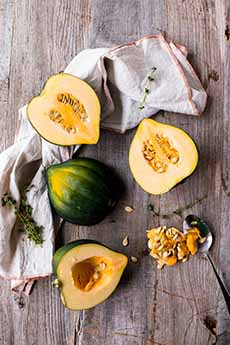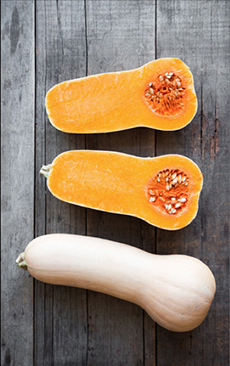|

[1] Acorn squash, one of the two most-available winter squash varieties for the table (photo © Kim Daniels | Unsplash).

[2] Tied for first place: butternut squash (photo © Good Eggs).
|
|
It’s a little bit of a chore to scrape the seeds out of an acorn, butternut or other winter squash*.
Here’s a tip: Use an ice cream scoop!
Another tip: Before you begin to slice the squash, place it in the microwave for 2 to 3 minutes. It will be a lot easier to peel, seed and cut.
ROASTING THE SEEDS
Some people clean the seeds to roast. We don’t have an easy way to do that yet, but here’s a thought:
You don’t have to remove every last bit of string and flesh pumpkin from the seeds.
PREHEAT the oven to 300°F.
PLACE the seeds in a bowl of water and soak them briefly, rubbing the seeds back and forth with your fingers or palms and pinching to dislodge as much string as you can.
Don’t go crazy. These are a fun food, not a frustrating one. Roast what you have, strings and all.
PAT dry and toss the cleaned seeds in bit of oil and salt, just enough to lightly coat. Add optional seasonings: chili powder, cumin, oregano, paprika, rosemary or other favorites.
SPREAD in a single layer on a rimmed baking sheet. It’s O.K. if there is some overlap.
ROAST until the seeds are just starting to brown, 20 to 25 minutes. You can stir them halfway through.
STORE the seeds at room temperature in an airtight container at room temperature for up to 3 days.
You can also use sweet seasonings, trading oil and salt for maple syrup and brown sugar, plus optional fall spices: allspice, cinnamon, clove, ginger, nutmeg. A pinch of salt is a good addition.
We use the roasted seeds as a general garnish, in grains and salads, and in yogurt. Here are:
> 20 Uses For Roasted Winter Squash Seeds, Including Pumpkin
> HOW TO CUT & PEEL WINTER SQUASH
> THE HISTORY OF ACORN SQUASH
________________
*You can tell winter squash from its thick, hard exterior. You need force in order to slice into it. Acorn, butternut, delicata, hubbard, pumpkin, spaghetti squash and others are winter squash. Summer squash has a thin peel that can be eaten. Yellow squash and zucchini are examples.
|




